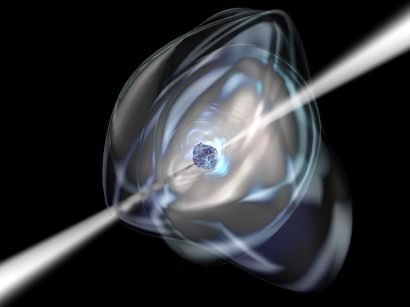تنها کافی است ادامه این متن را بخوانید تا متوجه موضوع شوید .
Observational data from nine pulsars, including the Crab pulsar, suggest these rapidly spinning neutron stars emit the electromagnetic equivalent of a sonic boom, and a model created to understand this phenomenon shows that the source of the emissions could be traveling faster than light. Researchers say as the polarization currents in these emissions are whipped around with a mechanism likened to a synchrotron, the sources could be traveling up to six times light speed, or 1.8 million km per second. However, although the source of the radiation exceeds the speed of light, the emitted radiation travels at normal light speed once it leaves the source. "This is not science fiction, and no laws of physics were broken in this model," said John Singleton of Los Alamos National Laboratory at a press briefing at the American Astronomical Society meeting in Washington, DC. "And Einstein’s theory of Special Relativity is not violated."
This model, called the superluminal model of pulsars, was described by Singleton and colleague Andrea Schmidt as solving many unanswered issues about pulsars."We can account for a number of probabilities with this model," said Singleton, "and there is a huge amount of observational data available, so there will be ample opportunities to verify this."
Pulsars emit amazingly regular, short bursts of radio waves. Within the emissions from the pulses, the circulating polarization currents move in a circular orbit, and its emitted radiation is analogous to that of electron synchrotron facilities used to produce radiation from the far-infrared to X-ray for experiments in biology and other subjects. In other words, the pulsar is a very broadband source of radiation.
However, Singleton said, the fact that the source moves faster than the speed of light results in a flux that oscillates as a function of frequency. "Despite the large speed of the polarization current itself, the small displacements of the charged particles that make it up means that their velocities remain slower than light," he said.
These superluminal polarization currents are disturbances in the pulsar’s plasma atmosphere in which oppositely-charged particles are displaced by small amounts in opposite directions; they are induced by the neutron star’s rotating magnetic field. This creates the electromagnetic equivalent of a sonic boom from accelerating supersonic aircraft. Just as the “boom” can be very loud a long way from the aircraft, the analogous signals from the pulsar remain intense over very long distances.
Back in the 1980s, Nobel laureate Vitaly Ginzburg and colleagues showed that such faster-than-light polarization currents will act as sources of electromagnetic radiation. Since then, the theory has been developed by Houshang Ardavan of Cambridge University, UK, and several ground-based demonstrations of the principle have been carried out in the United Kingdom, Russia and the USA. So far, polarization currents traveling at up to six times the speed of light have been demonstrated to emit tightly-focused bursts of radiation by the ground-based experiments.
Although Singleton and Schmidt's highly technical presentation was admittedly over the heads of many in attendance (and watching online), LANL researchers said the superluminal model fits data from the Crab pulsar and eight other pulsars, spanning electromagnetic frequencies from the radio to X-rays. In each case, the superluminal model accounted for the entire data set over 16 orders of magnitude of frequency with essentially only two adjustable parameters. In contrast to previous attempts, where several disparate models have been used to fit small frequency ranges of pulsar spectra, Schmidt said that a single emission process can account for the whole of the pulsar’s spectrum.
"We think we can explain all observational data using this method," Singleton said.
When asked, Singleton said they have received some hostile reactions to their model from the pulsar community, but that many others have been "charitably disposed because it explains a lot of their data."
Papers: Singleton et al,, Ardavan, et al, Ardavan, et al
